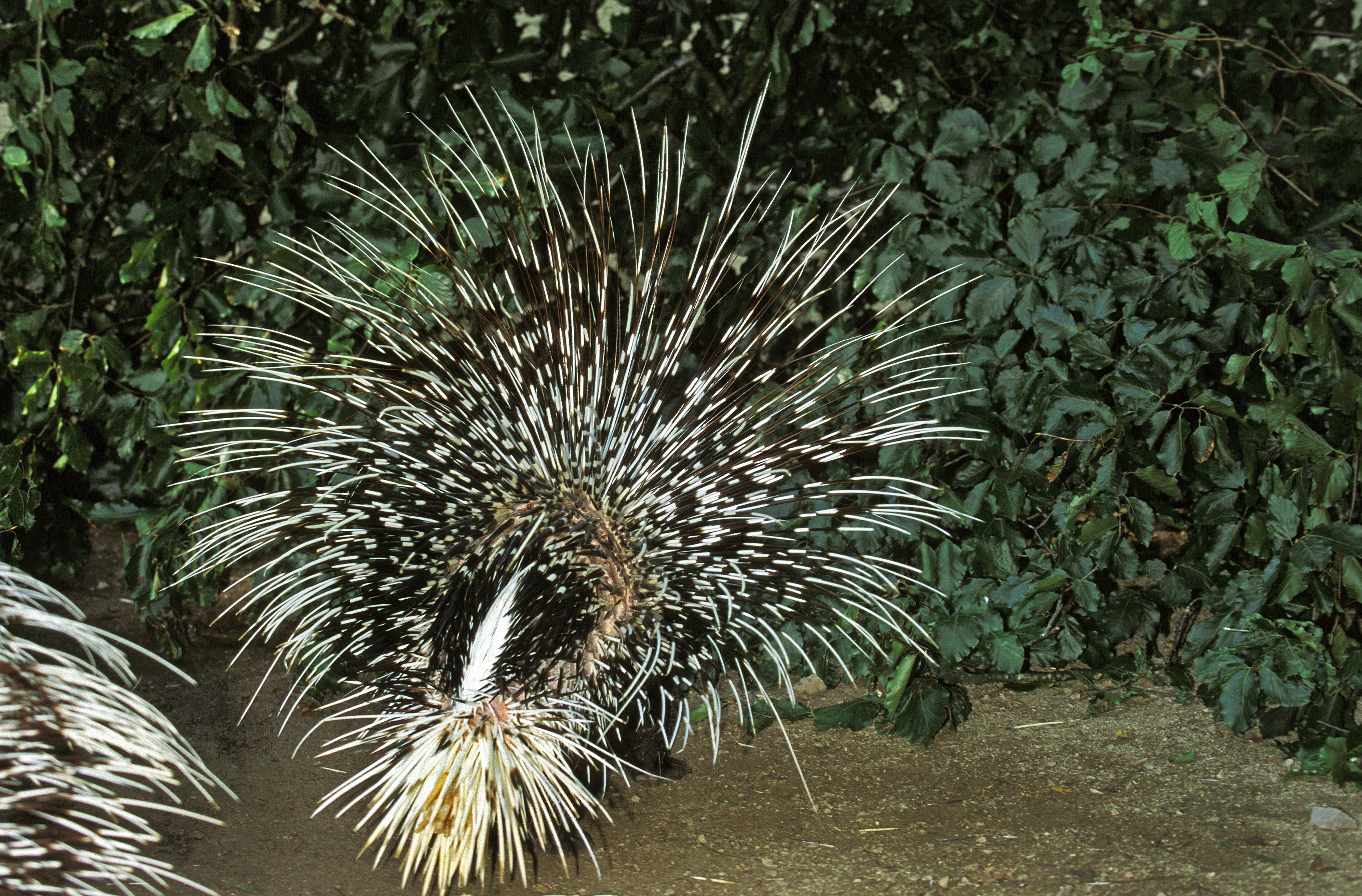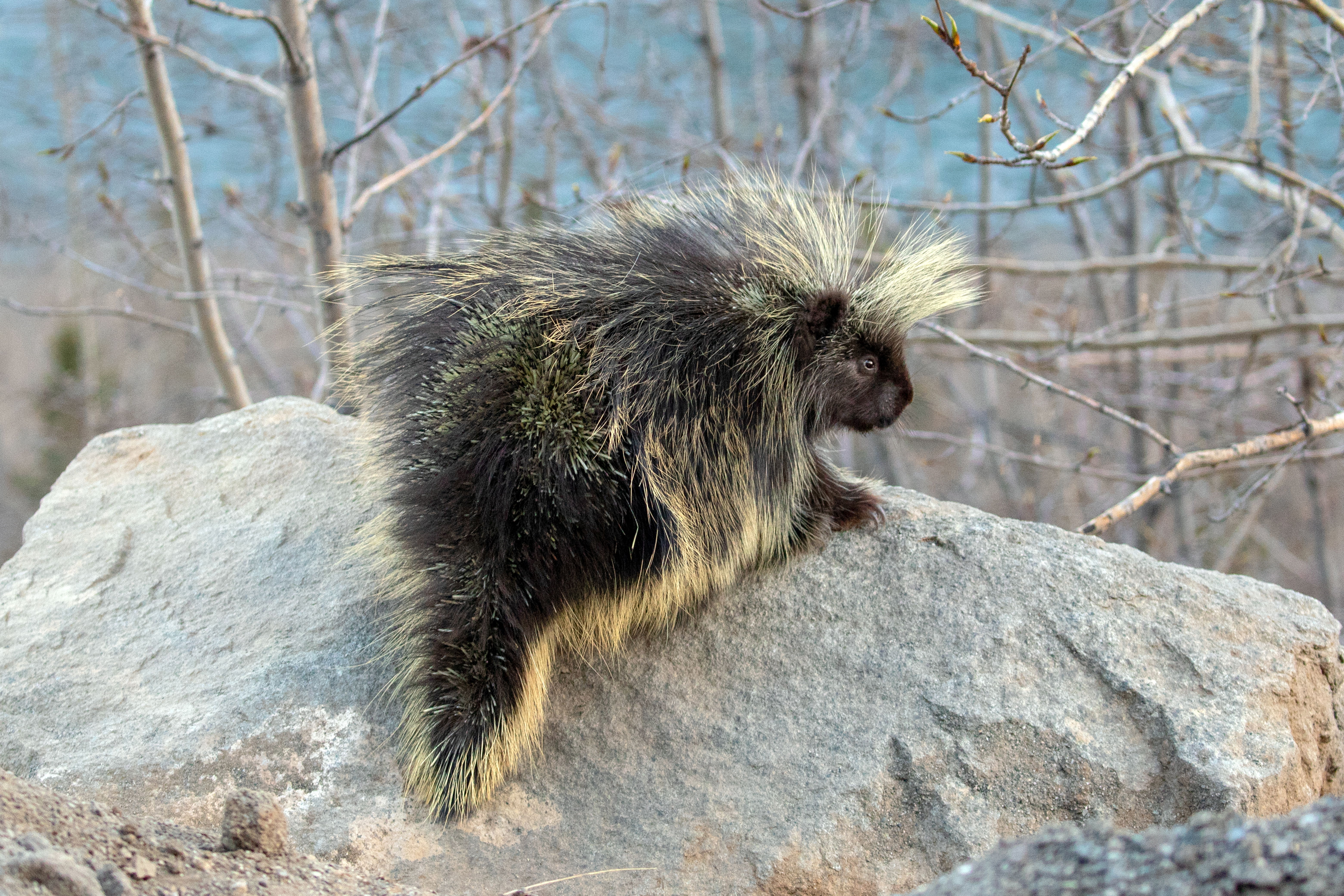Featured Creature: Porcupine
When you consider both the likelihood of an encounter and the potential for harm, the slow, sweet, unassuming porcupine is one of the biggest risks to your dog when out in the woods. One study found that over 2% of all emergency vet hospital visits were for quilling.

I’ve helped care for porcupines in wildlife rehabilitation, so I’ve worked with them in close proximity, and I can say, they are among the most gentle, nonaggressive animals! They really don’t want to attack your pup. They become a risk because they need to defend themselves from overly curious or aggressive dogs or other threats. Porcupines are strict vegetarians, so they definitely aren’t out to eat fido! (Porcupines eat bark, leaves, nuts, flowers and fruit– basically all things plant parts).

Let's start by talking a little about the risk a porcupine poses to your dog. Porcupine quills are an impressive defence adaptation! The quills are modified hairs that stiffen and are hollow. This is more than just a fun fact. It’s important to be aware of because this adaptation has two important functions that you as a pet owner need to know about: (1) it is highly unlikely that a quill will come out on it’s own. Instead, they work their way further into the skill, and (2) the hollow feature of the quill means that if you cut the quill, it could “deflate” and end up being even more difficult to remove. Another adaptation that makes quills difficult to remove is that they are barbed. Each of a porcupine’s 30,000(ish) quills has 700-800 tiny one-way barbs which help them go in deeper and make it very difficult to pull them out the other way! And the quill is designed to “let go” of the porcupine very easily (they don’t actually shoot them, but it takes very little pressure for the quill to enter the would-be attacker and be pulled from the porcupine). When a porcupine feels threatened, they lift up their quills, spin around so their back is facing the attacker and then slap their quilled tail up and down.
If your dog gets quilled, it’s important to call your vet. In some cases, you may be able to remove the quills yourself, but it’s likely you’ll need help from a veterinarian (and possibly a sedative).

Unfortunately, quills can have some very serious complications. Most dogs get quilled in the face (since the dog is usually investigating or possibly biting the porcupine). This leaves sensitive areas like nose and eyes vulnerable. In addition, because of the adaptations that quills have, quills that don’t get fully removed can migrate deeper and impact organs like lungs or can become infected. Most veterinary journal articles recommend that a dog be closely monitored for at least 3 months after a quilling if there is a possibility any were left.
Since you definitely want to avoid a quilling incident, it’s important to know when and where you are most likely to encounter these docile but dangerous creatures.

🐾Range: The porcupine’s range is not as straight forward as you might think. While pretty much all range maps show porcupine all over the western part of North America extending from the Mississippi to move across to the Pacific Northwest (except Texas and California). But in the East some maps show the range stopping in Connecticut and others show their range extending to Virginia. But, if you are here in New England where I live I can assure you that we have a good population of these adorable pincushions!
🐾Habitat: Porcupines are surprisingly adaptive. Porcupines have even been found in the desert southwest! But, given that their diet is exclusively plants, leaves, berries and bark, it’s not surprising that they are far more likely to be found in the forest. More specifically in the summer you will find them in the deciduous and mix forests (so in forest where the trees lose their leave in winter, but have nice tender leaves in the spring and summer). Porcupines love to munch on the leaves and berries of trees and bushes! In the winter their range shrinks as much as 80% and they stick to the coniferous or evergreen forests which have green needles all winter long (Porcupines are particularly fond of Hemlock trees). The Evergreens also provide better shelter from the snow making it easier for porcupines to get around on their short little legs. So in the summer you will want to be especially cautious in the leafy forest, but in the winter more cautious in the evergreen forest.
🐾Den sites: If you are in porcupine habitat in porcupine range, than you definitely want to avoid porcupine dens! Here is what to look for: Porcupine dens are usually in either rocky crevices or in trees with hollows or cracks (these cracks are often created by a lightening strike). You can pick them out be the mound of porcupine poop spilling out of the den! Porcupines are not particularly good housekeepers! They poop in their dens and when it gets to be too much they push it out the door and where it land it lands– they would have fit right in during the European Middle Ages!
Porcupine poop looks a bit like deer or rabbit poop, but it’s more oblong in shape and about ¾ of an inch long. It’s also not uncommon to find quills in among the poop– a tell, tell sign of porcupine! Oh and porcupines smell like strong human B. O.-- so maybe that smell is not you hike partner– maybe there a “quill-pig” near by. (Of course if your backpacking and haven’t showered in a few days it may be you!)
Some experts thing that as many as 80% of porcupine dens are in Rocky crevices or stone walls foundations of old buildings. So it’s a really good idea to avoid letting your dog stick his nose in these features!
🐾Time of Year Now that you know a little about where to look out for them, lets talk a little about when you are most likely to “come upon” a porcupine. According to one study, porcupine/ dog encounters are most common in the fall and least common in winter. But I’ve know dogs to get quills in winter, so its not unheard of, after all porcupine are not hibernators so they are around in all seasons. All since porcupines change their habitats with the season, location in different seasons is important too. In winter porcupines prefer coniferous forests (so you are less likely to come upon one in the leafless deciduous forest, but it the spring, summer and fall, it’s the deciduous forest where they spend their time.
Another thing to note: The likely reason that Fall is the most common time for encounters with dogs is that fall is breading season for porcupines. They are far more likely to be on the ground in fall. Yes, porcupines are actually very good climbers and spend most of their time in the trees!
🐾Time of Day: Porcupines are most active in the evening and at night. That same study that found that fall is the most common time for quilling events, also found that most of those quilling vet visits are to after hours emergency room vet clinics!
So since no one wants to make an emergency trip to the vet for quill removal (and because the porcupine would rather keep his quills, thank you very much!) here are some tips to remember!
🐾Leash up in the evening and at night.
🐾Don’t let your dog visit rocky hillsides, rock foundations, or hollow logs
🐾Be especially vigilant in deciduous forest in the spring, summer and even more so in the fall.
🐾Don’t think that because your dog was quilled once they will “learn a lesson” and avoid them in the future.
🐾Don’t expect that the porcupine will hurry away because they hear you coming, or run away from your dog. Nope– porcupines have short legs and lots of quills so they stay put and expect you to stay away!